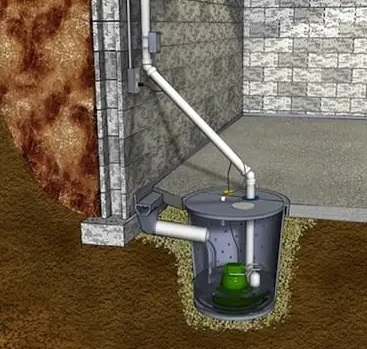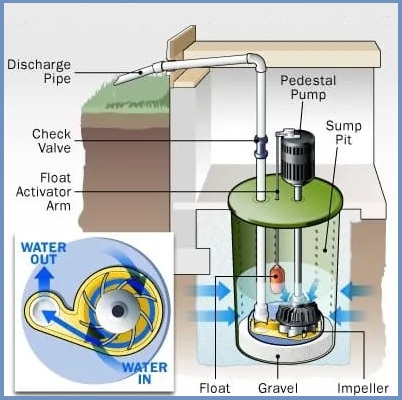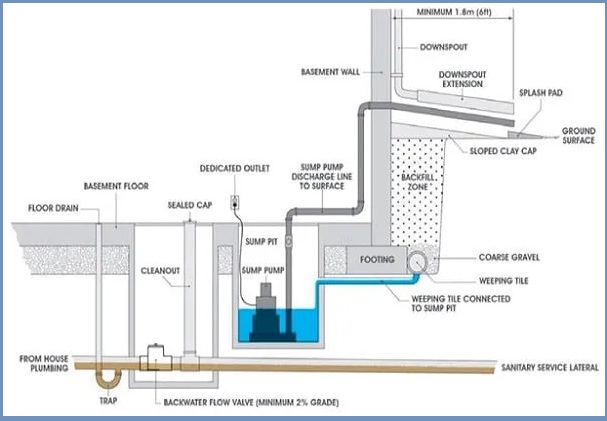Sump pit is a transient hole built to accumulate and clear out extra water for pumping to the favored drainage area. Sump pits also are called wetland basins.
Sump pump has a vertical riser pipe for amassing filtered water. This vertical standpipe has a hole. Sump Pump The essential characteristic of a sump is to eliminate extra water and enhance water quality.

The sump pit has a sump pump that periodically removes excess water from the pit to prevent it from overflowing. Proper maintenance of the pump and manhole is critical to the proper functioning of the system.
Your basement is the most suitable place where you can collect maximum water to protect it from flooding. Therefore, you must install your pit in the basement.
When the water level in the surrounding area rises above the basement, it begins to flow from the surrounding area into the basement and causes many problems.
In the event of heavy rain, especially if you don’t have a septic tank or well-maintained gutters, water can enter your basement from where it can flow freely in various places. When water floods a basement, it causes severe damage, promotes mold growth, and poses various health risks.
Therefore, you must install a sump in your basement. This way, you can easily collect and drain rain or excess water from your basement and prevent various health hazards.
Table of Contents
Importance of Sump Pit
Sump Storage tanks are most commonly used in various industries and homes. They use to remove excess water from a specific area to the desired area. Sump pumps are most commonly used in different homes to remove water and other liquids. A sump pit is also known as a tank or carpool.
Working Principle of Sump Pit
The sump pit work as a hole used to collect water and other spilled liquids. Tiling the drainpipe is one of the methods of unclogging a septic tank.
These bricks have holes. They are installed horizontally in the basement. They install at a specific angle for excellent discharge. The angle of these bricks confirms that the water will stay where you want it. Drain bricks are often used around the construction of a house, but not necessarily there.

The sump pit works as follows:
As explained above, pits are most commonly installed in basements. In the surrounding area, water collects in the basement and enters the pit. A drainage pump is installed in the pit.
Each pit has a different water level storage capacity. There is a water level detector in the pit. When the water level in the pit reaches a certain level, the detector activates the pump to detour the water in the pit to the desired area.
Its Construction
Sump pits are used to collect a variety of liquids and materials. For example, an auto repair shop has a pit for collecting spilled diesel, gasoline, lubricants, and other liquids. The collection pit is also used in hospitals and medical supplies stores to collect hazardous waste. In this case, special care is required for pit maintenance.

In the pit, there is a drainage pump used to pump the collected waste. You can also use the pits to catch small debris. Therefore, sometimes algae can grow in them. Therefore, it is necessary to flush the pits on a regular basis and pay special attention to cleaning the pump parts to prevent clogging of the pump line. This can be unpleasant, but it can prevent overflow. If you clean the pits regularly, it will work properly and the system will not take long to clean.
First, you need to unplug the pump and wear gloves to clean the pits. You can also use the portable workshop lights and tarps to place the pump while cleaning the pits for a clear view of the area.
How to Clean out a Sump Pit? Complete Procedure
- Turn Off the Sump Pump and Remove the electricity delivery connection: First of all, disconnect the electricity delivery of the sump pump and flip it off. The pump should be unplugged from the AC outlet. It can be very unsafe in case you attempt to smooth your pit and pump without disconnecting the electricity connection.
- Drain Pipe elimination: Remove the pump from the drain pipe.
- Sump Pump elimination from the Pit: Wear gloves, put off your pump from the pit, and vicinity it out of doors of the pit.
- Wrap the pump: Wrap a plastic sheet around the lowest of the pump to keep away from extra cleansing. You should vicinity the pump in a region that allows you to get admission to all facets of the pump for snug cleansing.
- Sump Pump cleansing: Spray the lawn hose over the pump to smooth it. As you spray the pump, all of the unfastened particles and different contaminations may be eliminated; make use of a cleansing tool (which includes a cleansing brush) to cast off the stuck-on residue from the pump.
- Rinse the pump: Spray the lawn hose over the pump one extra time to cast off the last particles.
- Drain the take a look at valve: Now, cast off the last water from the take a look at the valve. Use a bucket to acquire the valve water.
- Use a dry/moist vacuum to empty the last water from the sump pit. Now use a store vacuum to cast off any residue or status water withinside the sump pit bottom.
- Reconnect the pump. After pump and pit cleaning, it’s time to reconnect all of the connections and additives lower back to their places. Reconnect the pump to the electricity supply and flip it on to test both your pump is operating great or not.
